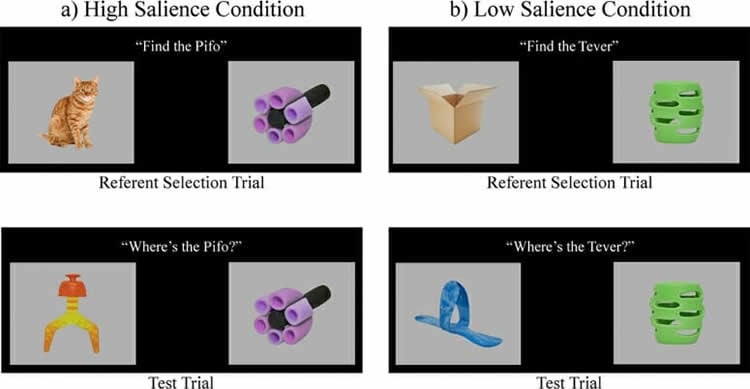Summary: According to researchers, familiar images that are more interesting to children may distract them from focusing on novel objects and reduce the ability to learn new words associated with the novel stimuli.
Source: University of Wisconsin Madison.
Say you are shown an apple, a banana and a fruit you have never seen before. Then you are asked to pick the “pifo.” Which fruit would you choose?
Chances are you would select the novel fruit. Children often use the same strategy — leveraging their knowledge of familiar objects — to learn new words and connect them with unfamiliar or novel objects by process of elimination. So it might seem that having familiar objects around would help children learn new words.
That’s what researchers thought, too, but a new study directed by University of Wisconsin–Madison psychology professor Jenny Saffran is the first to show that familiar objects can sometimes be a “double-edged sword” — both helping children learn new words and hindering them.
“It’s pretty universally accepted that familiar objects help children learn new words,” says study co-author Ron Pomper, a graduate student in Saffran’s Infant Learning Lab at the Waisman Center. “We show that it’s more nuanced than that.”
Published recently in the journal Child Development, the study found that familiar objects that are more interesting to children — brightly colored ones, or animals or food, for example — distracted them from focusing on novel objects and reduced their ability to learn new words associated with those objects.
This surprised Pomper and Saffran, who were working with children from just older than 3 years to almost 4 — from 38 months to 45 months, to be exact. The Infant Learning Lab studies development among children 6 months to 6 years of age.
“Although they might make it look easy, children are working very hard to learn new words,” says Pomper. “This study shows that not all word-learning opportunities are equal. If a cat walks in, for example, it may not be the best time for a child to be learning new words.”
To further explore whether interesting familiar objects distract children from novel objects, the researchers showed children a pair of images: one of a familiar object, like a cat or a box, and one of a novel object. While the children were looking at the images, they heard a sentence that contained a new word, like, “Find the pifo” or “Where’s the tever?”
Researchers tracked children’s gazes and found that they spent significantly less time looking at the novel object when the familiar object was more interesting, like a cat, compared to when the familiar object was less interesting, like a box.
When the familiar object was more interesting, the children also took longer to shift their gaze to the novel object after hearing the sentence containing new words, like “pifo” or “tever.”
To find out if having more interesting familiar objects hindered children’s ability to connect new words with novel objects, the researchers did a second test in which they showed the children the novel object from the first test (those labeled as a “pifo” or a “tever”) but added a second novel object. Then they asked the children to find the “pifo” or “tever” again.

If the familiar object in the first set of tests was more interesting, it was basically a coin toss whether the children were able to correctly identify the “pifo” or “tever” in the second test. But if the familiar object was less interesting — such as a box or a piece of furniture — children connected the new word to the correct novel object significantly better than random chance would predict.
“Most words that children know are things that they are really interested in,” says Pomper. “Interesting objects may often be really distracting in natural settings and not actually help children learn new words.”
In future research, Pomper and Saffran plan to re-create different aspects of children’s natural settings — with objects that move or make sounds, for example — to better understand how the environment can influence children’s ability to acquire new words and language.
Funding: This study was funded by the Eunice Kennedy Shriver National Institute of Child Health and Human Development, The National Institute of Deafness and Other Communication Disorders, and a James S. McDonnel Foundation grant.
Source: Adityarup “Rup” Chakravorty – University of Wisconsin Madison
Publisher: Organized by NeuroscienceNews.com.
Image Source: NeuroscienceNews.com image is credited to Pomer and Saffran.
Original Research: Abstract for “Familiar Object Salience Affects Novel Word Learning” by Ron Pomper and Jenny R. Saffran in Child Development. Published March 7 2018.
doi:10.1111/cdev.13053
[cbtabs][cbtab title=”MLA”]University of Wisconsin Madison “Here’s How a Cat Can Hinder Children Learning New Words.” NeuroscienceNews. NeuroscienceNews, 5 April 2018.
<https://neurosciencenews.com/word-learning-cat-8729/>.[/cbtab][cbtab title=”APA”]University of Wisconsin Madison (2018, April 5). Here’s How a Cat Can Hinder Children Learning New Words. NeuroscienceNews. Retrieved April 5, 2018 from https://neurosciencenews.com/word-learning-cat-8729/[/cbtab][cbtab title=”Chicago”]University of Wisconsin Madison “Here’s How a Cat Can Hinder Children Learning New Words.” https://neurosciencenews.com/word-learning-cat-8729/ (accessed April 5, 2018).[/cbtab][/cbtabs]
Abstract
Familiar Object Salience Affects Novel Word Learning
Children use the presence of familiar objects with known names to identify the correct referents of novel words. In natural environments, objects vary widely in salience. The presence of familiar objects may sometimes hinder rather than help word learning. To test this hypothesis, 3‐year‐olds (N = 36) were shown novel objects paired with familiar objects that varied in their visual salience. When the novel objects were labeled, children were slower and less accurate at fixating them in the presence of highly salient familiar objects than in the presence of less salient familiar objects. They were also less successful in retaining these word‐referent pairings. While familiar objects may facilitate novel word learning in ambiguous situations, the properties of familiar objects matter.






